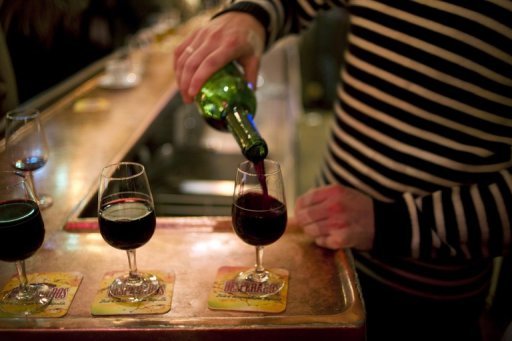
China is planting more and more vineyards, the US is reclaiming wine regions abandoned during Prohibition and the English are producing more bubbly than ever before.
And with global production expected to increase still further in coming decades the supply of wine would seem assured for some time to come.
“There are new vineyards (in China), so many new vineyards planted that have not yet begun producing,” said Bruno Butragueno, Asia Pacific director for Rioja giant Compania Vinicola del Norte de Espana.
But that view was dealt a blow last month with the publication of a report predicting a global wine shortage and higher prices.
US bank Morgan Stanley forecast a shortfall with wine drinkers demanding more than the world’s vineyards can produce.
Allan Sichel, vice president of the Bordeaux Wine Council, said demand was growing steadily in Japan and exports to America had increased by 15 percent.
And demand in countries such as newly wealthy China is only predicted to rise too.
“With more and more Chinese travelling overseas (…) being introduced to wine and experiencing the western drinking culture, it will only bring up the demand,” said Judy Leissner, CEO of Grace Vineyards in China.
According to the International Organisation of Vine and Wine, global wine production will continue to expand, reaching 281 million hectolitres (Mhl) this year compared to 258 in 2012.
English sparkling wines are contributing to that boost in production.
“The future for English sparkling wine is extremely bright with new producers establishing themselves every day and hundreds of hectares of new vineyards being planted regularly across (southern counties) Sussex and Hampshire and Kent,” said Christian Holthausen of Nyetimber, which pioneered English sparkling wine 25 years ago.
In Argentina, too, Bodegas Santa Ana — with an annual production of 60 million bottles — continues to plant new vines and buy up existing vineyards, according to export manager Martin Navesi.
But is it enough to quench the global thirst for wine?
Growers say their cellars are far from empty.
?We have stock. Port has the rule of three ?- for every bottle you sell, you must stock two bottles,? said Jorge Nunes, Asia Pacific representative for Port wine producer Symington.
Indeed, Leissner said there was even a surplus of wine in China and that future demand would be met by domestic supply.
?At the moment, I don’t see there is a wine shortage in China,? said Leissner, who produces two million bottles a year. ?Many local wineries are unable to sell their wines.?
Grapes aplenty
Martin Navesi, export manager of Argentina’s Bodegas Santa Ana, rejected any idea of a shortage.
?We haven?t seen any significant increase in demand from China and the US -? there is a lot of room for growth,? he said.
Rioja producers also dismissed the report.
?We have no data to suggest there is a wine shortage worldwide,? said Butragueno. ?The only shortage that we can conceive is with super premium, high-end wines from established houses and specific regions, that have limited production.?
Producers also argue that Morgan Stanley?s forecasted wine shortage doesn?t take into account that the current supply of wine grapes could be used differently.
?Supplies vary year to year, but loads of wine is marketed as bulk wine,? said Navesi, referring to the cheapest wine sold unbottled.
?If demand outpaces bottled wine, they will stop making grape juice concentrate and bulk wine.?
Some of the worries over supply come from the drop in vineyard surface area. According to the OIV, around 300,000 hectares of vines have been lost since 2006.
But producers say many vines have been ripped up deliberately to ease a wine glut in the past.
“We’ve reduced production over the past decade, because supply was too big and quality was low,” said Loic Hemard, spokesperson for Inter Rhone which represents wine growers for Cotes de Rhone and the Rhone Valley.
By lowering yields, the vines produce better grapes and supply is in line with demand, keeping prices stable.
“Now we control the production to guarantee quality and a price.”
Morgan Stanley?s prediction of a price hike also caused some raised eyebrows from growers who remember unsustainably low prices of the past.
“For the last 40 years the world has been producing more wine than it consumed very often leading to prices being too low,” added Sichel.
“Surplus demand will put tension on prices but we know from experience that the market is very sensitive to price increases. An increase in prices will lead to a drop in demand,” he said.
And Navesi said the industry had plenty of room to manoeuvre.
“There is a lot of grape juice and bulk wine to be soaked up before there will be price increases,” he said.
